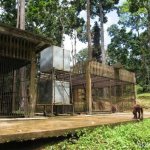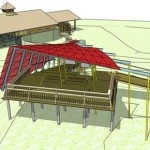Borneo Rhinoceros Conservation
This is an animal almost mystical by reputation, a huge, jungle dwelling herbivore which is so reclusive that even the scientists who study them must rely on camera traps, footprints and dung for their data. Their horns are alleged to be an aphrodisiac making them a notorious target for poachers, but this is not the only threat to their existence.
Habitat loss is the usual scapegoat for declining populations of wildlife but in the case of the Sumatran Rhinoceros there may also be other factors at work.
I am told that rhinos are not fussy in their choice of fodder so they are clearly not starving to death. This is especially obvious given that the increased undergrowth in logged over forest tends to work in favour of herbivores. For example; sambar deer are especially numerous in logged forest where there is no hunting pressure (such as in the Danum Valley Conservation Area). Similarly the elephant population in the Yayasan Sabah concession and Kinabatangan Floodplain is increasing.
Ecological science is yet to understand why rhinos continue to decline at rates much faster than environmental factors or human exploitation can explain. In search of answers, researchers are turning to genetics to provide some clues. Perhaps a tipping point of genetic viability in the rhino population was reached some time ago? What we are seeing now could be the effect of interbreeding between cousins and the gradual decline in health and fertility of the offspring that this can cause. Given the long life and extremely low breeding rate of the Sumatran Rhinoceros, this process could have been going on for a long time.
At the bottom line is a fear that the Sumatran Rinoceros may be an evolutionary anachronism. Conservationists are understandably cagey about how many rhinos remain and where, but I am given to believe that there may be less than 30 of the Bornean sub-species surviving, of which most of these are in Sabah. This population is believed to be in steady decline and many groups and/or individuals have been overtaken by land use change and are now isolated in small islands of forest in a sea of palm oil plantation. Without some kind of intervention it seems certain that their decline will be terminal.
The obvious step to take is to capture the fragmented population and put them together in one place in the hope that they will breed. Arkitrek is privileged to have been invited to help in assessing a potential site for a captive breeding program in Sabah. The idea is very simple and is to be based on a similar program at Way Kambas National Park in Sumatra.
Way Kambas has a captive population of 5 animals which are kept in wedge-shaped forest paddocks forming a circular plan with breeding paddock at the centre. Females are continuously monitored so that when they start to ovulate they can be put into the breeding paddock with a male. Despite the highest standards of animal care and husbandry, Way Kambas has yet to produce any offspring. Previous attempts to keep Sumatran Rhinos in captivity in Sabah have also had mixed success. The only successful captive breeding program is at Cincinnati Zoo in the USA, which has produced two offspring from the same mother. One of these youngsters is now at Way Kambas.
Cincinnati Zoo has provided one glimmer of hope that with good science, good husbandry and fertile and willing animals, it may be possible to delay or halt the decline of this flagship species. Whether a wild breeding population can be established to re-colonise the fragments of their former range remains to be seen. Often during my treks in the more remote corners of the Bornean jungle, I fantasise about meeting a rhino. The great thing about fantasy is that the encounter can involve me heroically standing my ground to get a full frame photograph of a charging, enraged beast before making a deft dummy to the left and a leap behind a tree to my right.
Related Posts







There is a great article on Borneo Rhinocerous Conservation here on mongabay. http://news.mongabay.com/2009/1201-hance_tam.html
Pingback: Conservation or Animal Welfare?